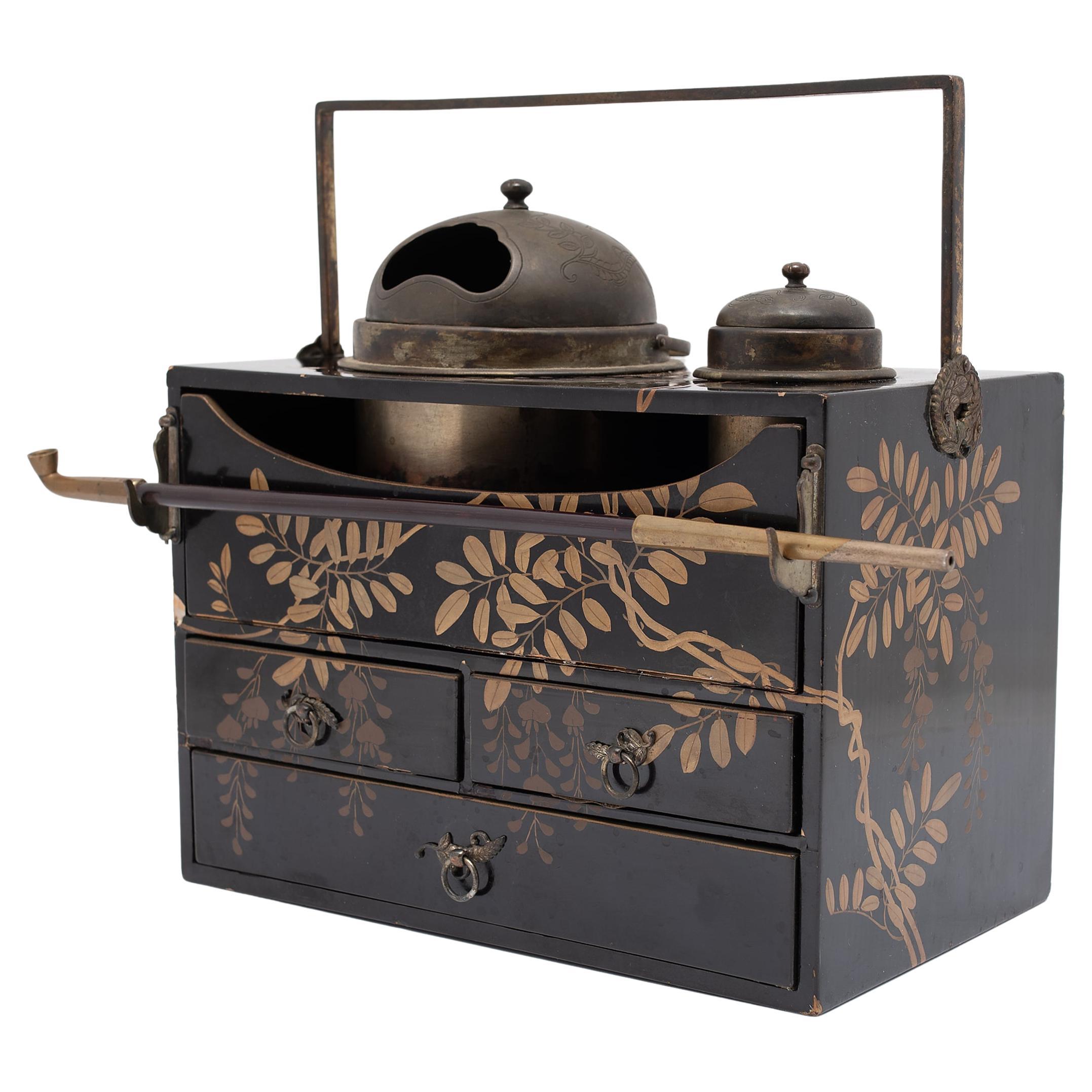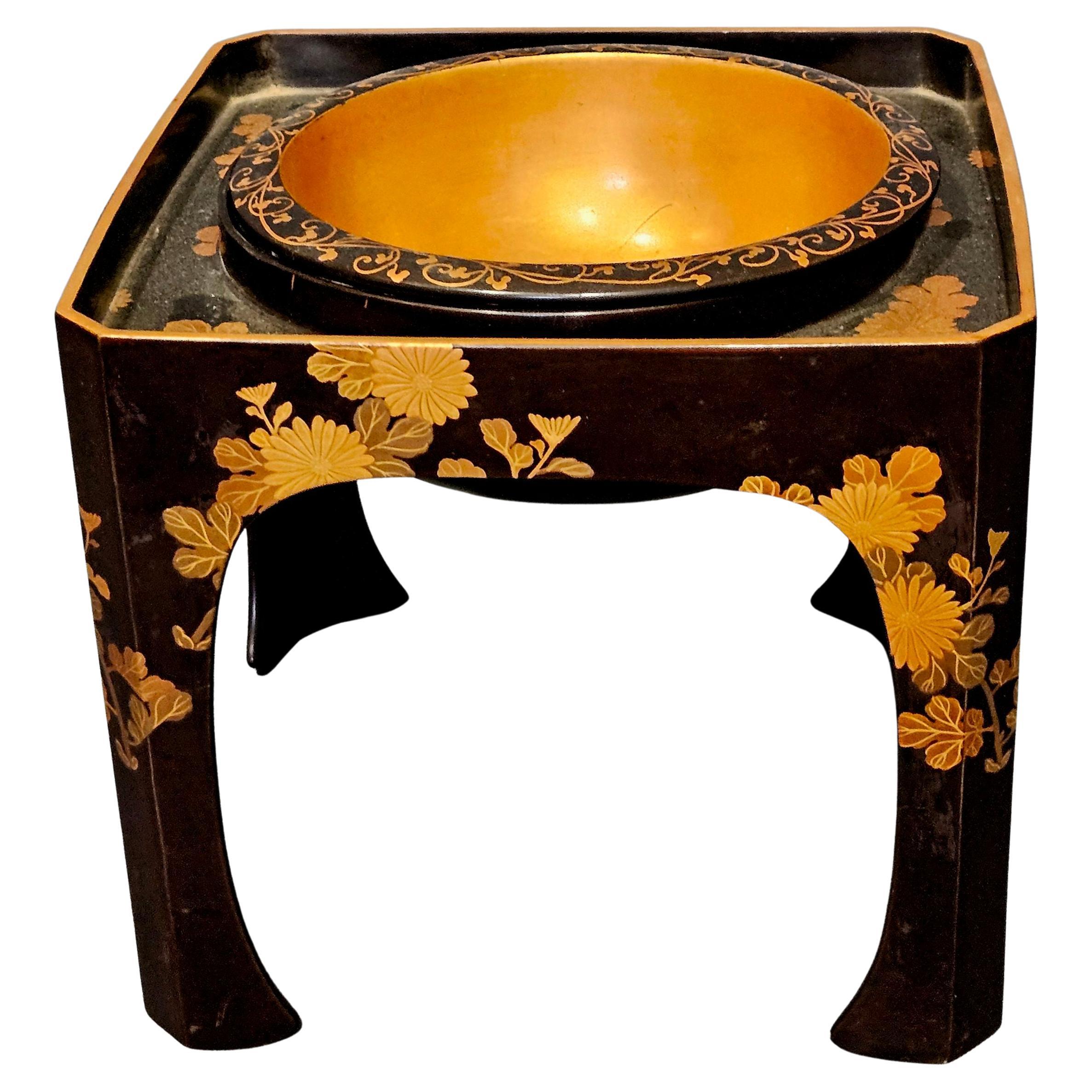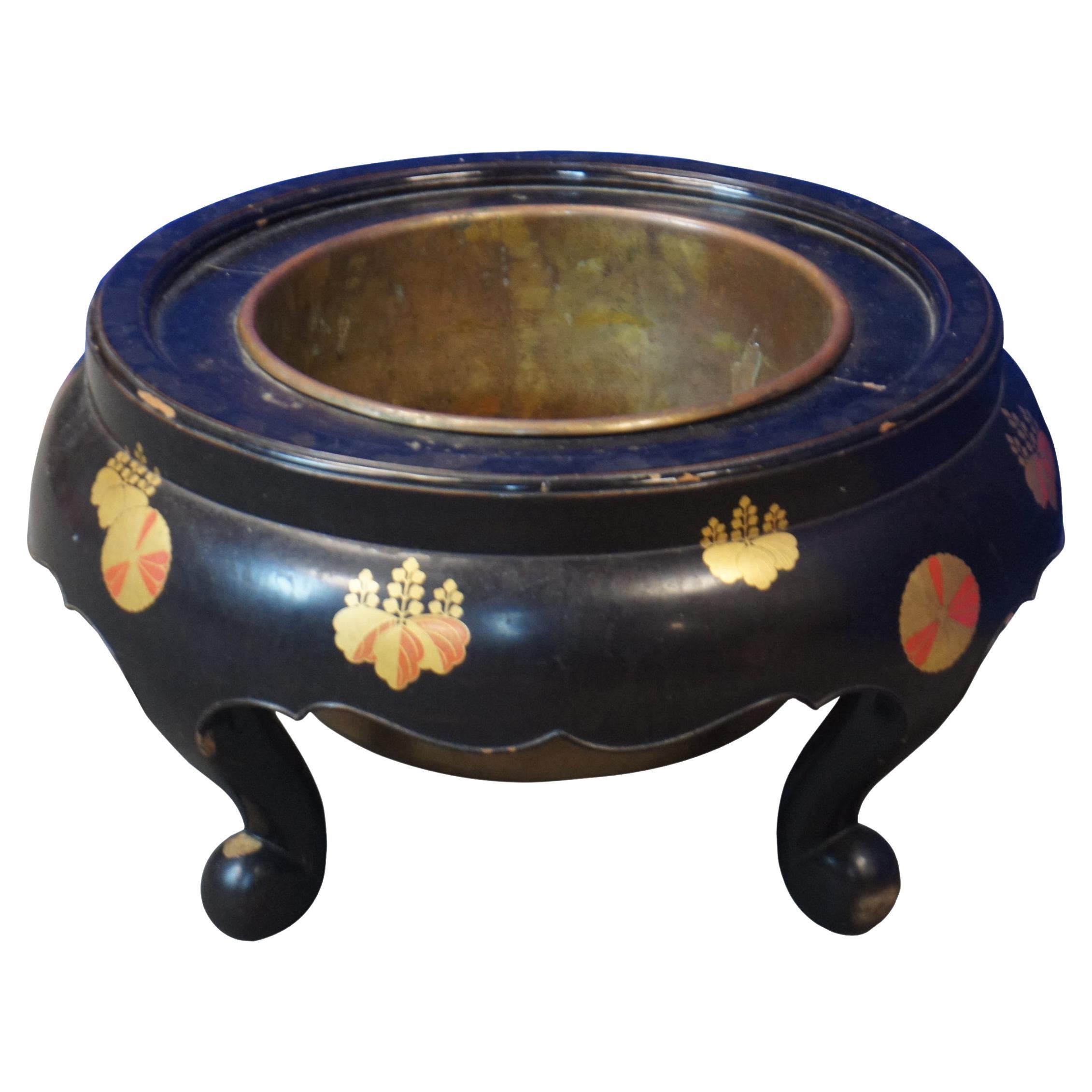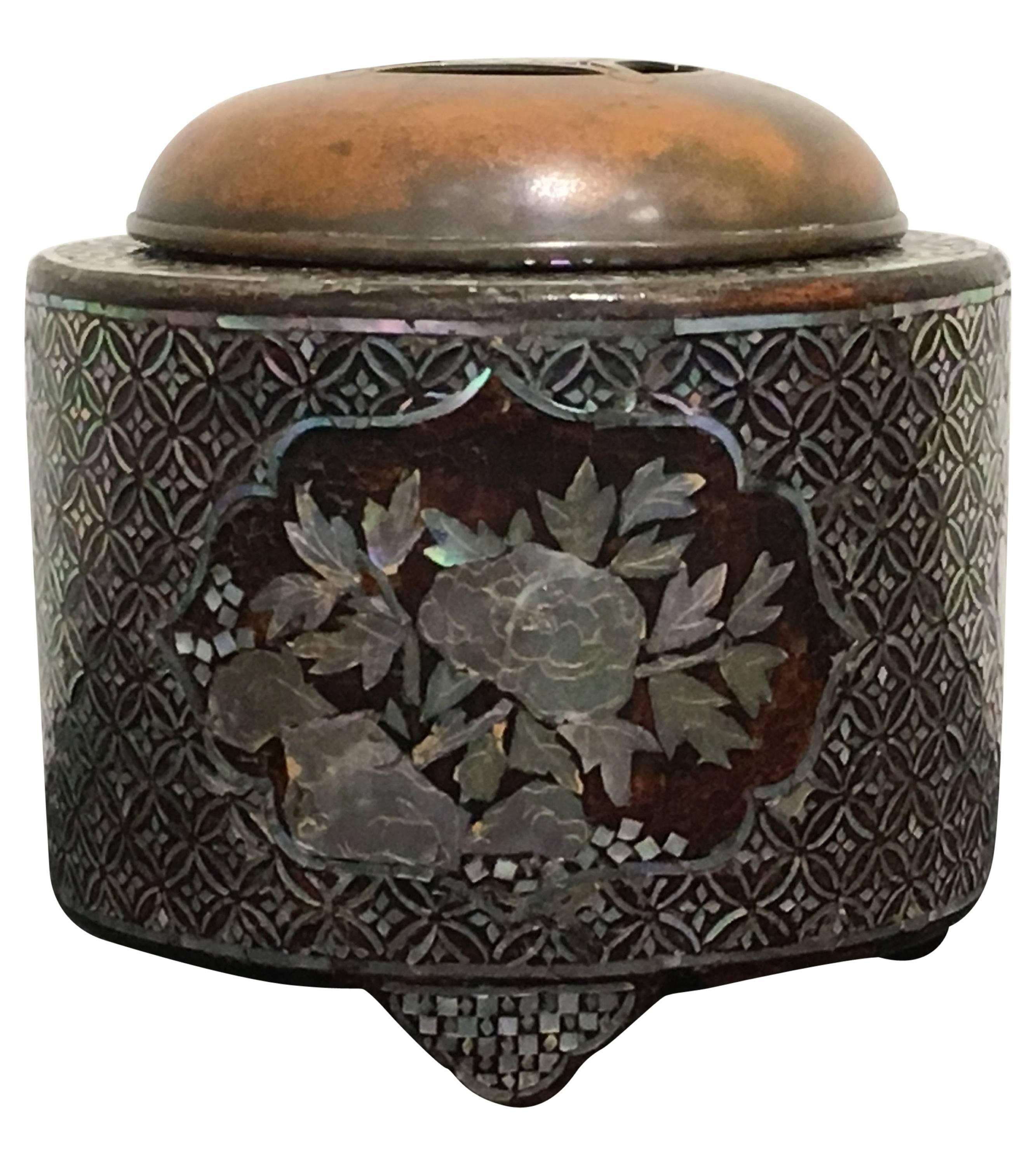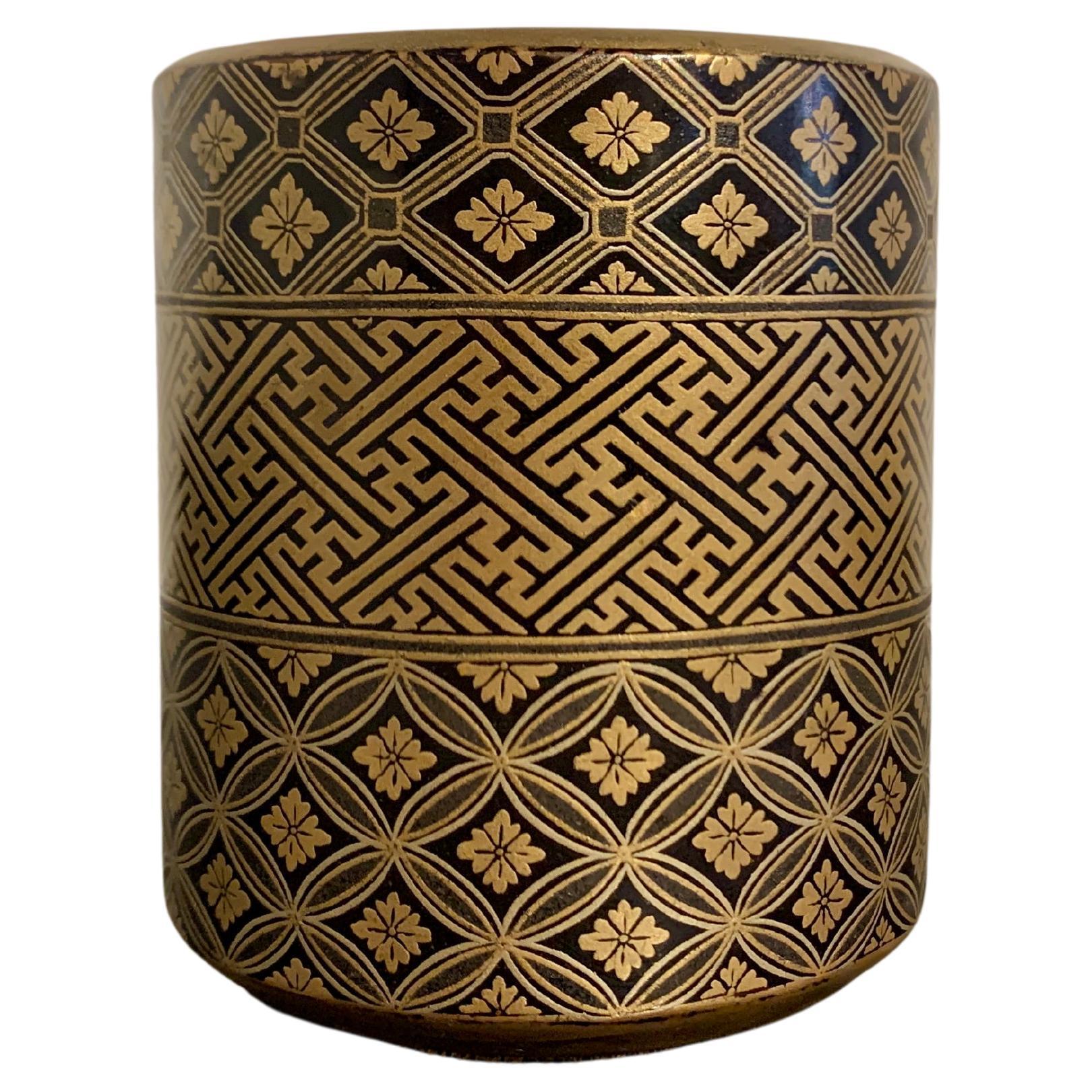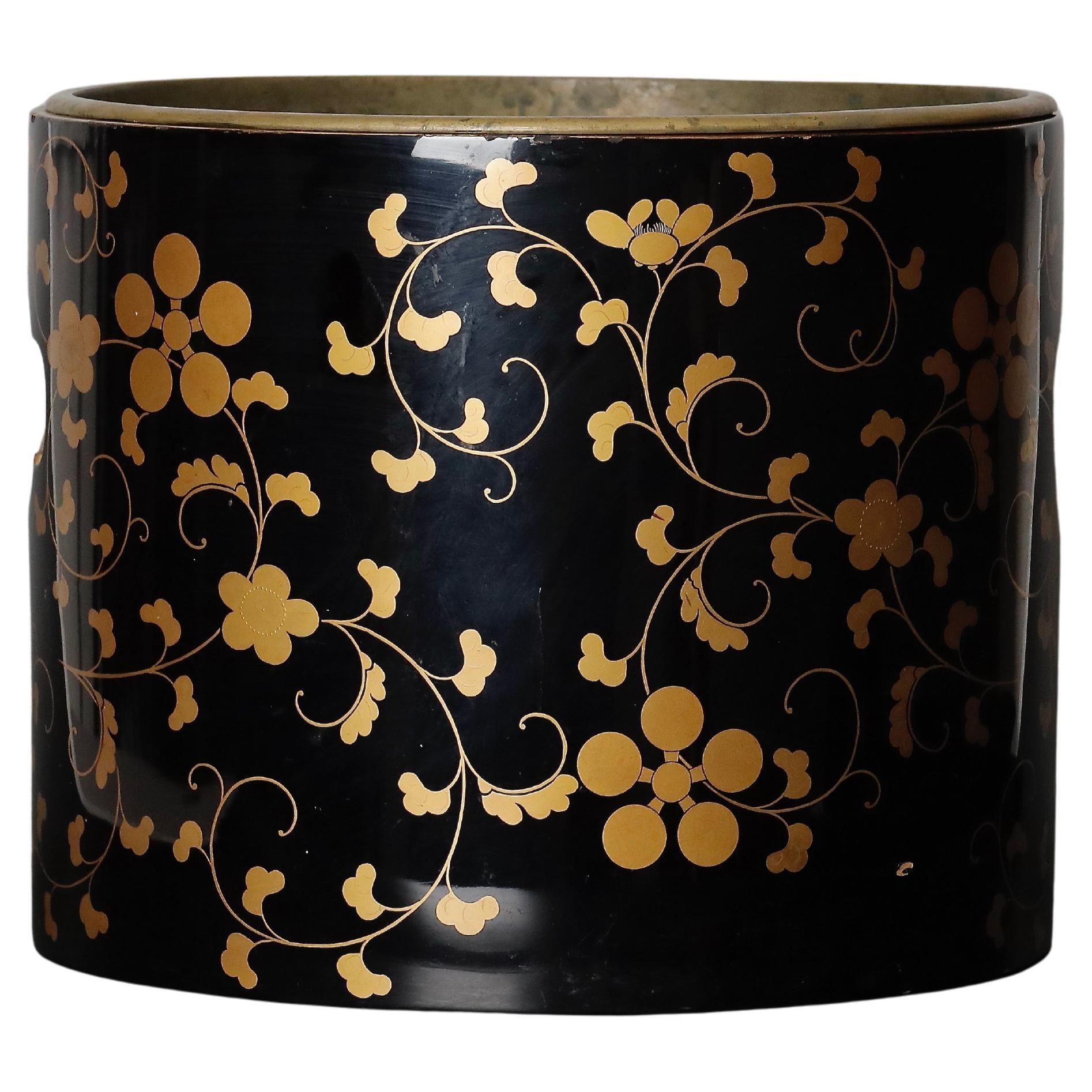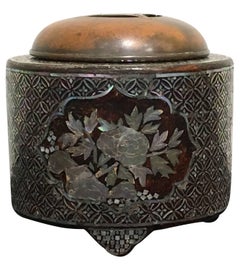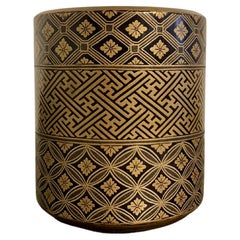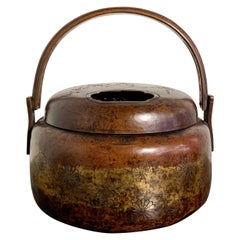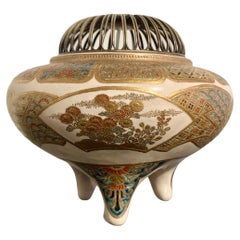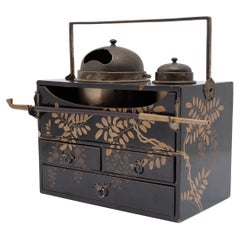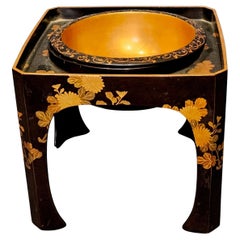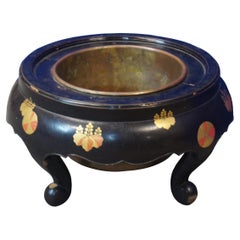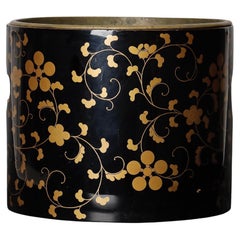Items Similar to Japanese Lacquer Hibachi with Imperial Chrysanthemum, Meiji Period, Japan
Want more images or videos?
Request additional images or videos from the seller
1 of 11
Japanese Lacquer Hibachi with Imperial Chrysanthemum, Meiji Period, Japan
$975
£749.06
€860.66
CA$1,371.46
A$1,540.77
CHF 805.06
MX$18,805.84
NOK 10,221.86
SEK 9,621.72
DKK 6,422.54
About the Item
A simple and elegant Japanese lacquer hibachi stand with imperial chrysanthemum mon and copper liner, now modified as an usubata, late Meiji Period, circa 1900, Japan.
The refined black lacquer hibachi stand of low table or stand form, with cabriole legs and gilt copper fittings. The black lacquer decorated with offset sixteen petal chrysanthemums in gold maki-e lacquer. The sixteen petal chrysanthemum is the symbol for the Imperial Seal of Japan, and the personal symbol of the Emperor.
Small stand or table from hibachi such as these were used by the nobility and literati as incense burners. The copper liner would be filled with sand with hot coals placed on top. The coal would be used to light incense sticks, which would then be placed upright in the sand.
The large copper lining rests in the large central opening and is removable. It is currently configured as an usubata, or vessel for ikebana (flower arranging). A large circular Kenyan (flower frog) with an additional tall metal spiral support is attached to the interior (also removable).
- Dimensions:Height: 5.5 in (13.97 cm)Width: 10 in (25.4 cm)Depth: 10 in (25.4 cm)
- Materials and Techniques:
- Period:1900-1909
- Date of Manufacture:circa 1900
- Condition:Additions or alterations made to the original: The copper liner fitted with a later kenzan (flower frog) and metal spiral support. Can be removed. Refinished. Wear consistent with age and use. Minor fading. The lacquer with evidence of refinishing. The copper liner polished. The exterior of the liner with small nicks and scratches. The interior heavily tarnished.
- Seller Location:Austin, TX
- Reference Number:1stDibs: LU894733012912
About the Seller
5.0
Gold Seller
Premium sellers maintaining a 4.3+ rating and 24-hour response times
Established in 2001
1stDibs seller since 2010
346 sales on 1stDibs
Typical response time: 1 hour
- ShippingRetrieving quote...Shipping from: Austin, TX
- Return Policy
Authenticity Guarantee
In the unlikely event there’s an issue with an item’s authenticity, contact us within 1 year for a full refund. DetailsMoney-Back Guarantee
If your item is not as described, is damaged in transit, or does not arrive, contact us within 7 days for a full refund. Details24-Hour Cancellation
You have a 24-hour grace period in which to reconsider your purchase, with no questions asked.Vetted Professional Sellers
Our world-class sellers must adhere to strict standards for service and quality, maintaining the integrity of our listings.Price-Match Guarantee
If you find that a seller listed the same item for a lower price elsewhere, we’ll match it.Trusted Global Delivery
Our best-in-class carrier network provides specialized shipping options worldwide, including custom delivery.More From This Seller
View AllJapanese Edo Period Lacquer and Mother-of-Pearl Embellished Stoneware Koro
Located in Austin, TX
A highly unusual Japanese crackle glazed koro (incense burner or censer), lacquered and inlaid with mother-of-pearl embellishment, signed Gyokusen, Ed...
Category
Antique 19th Century Japanese Edo Scholar's Objects
Materials
Copper
Japanese Lacquer Incense Burner, Koro, Edo period, mid 19th century, Japan
Located in Austin, TX
An elegant and refined Japanese lacquer koro, incense burner, in the form of a chaire, tea caddy, Edo Perio, mid 19th century, Japan.
The barrel shaped koro formed as a traditional ...
Category
Antique Mid-19th Century Japanese Edo Lacquer
Materials
Copper
Japanese Parcel Gilt Copper Hibachi, Edo Period, 18th Century, Japan
Located in Austin, TX
A sublime Japanese parcel gilt copper hand warmer, hibachi, with chrysanthemum design, Edo Period, 18th century, Japan.
The hand warmer, called a...
Category
Antique 18th Century Japanese Edo Metalwork
Materials
Copper
Japanese Satsuma Incense Burner, Koro, Meiji Period, Late 19th Century, Japan
Located in Austin, TX
A fine and elegant Japanese Satsuma tripod incense burner, koro, with pierced metal lid, signed Eizan (?) Meiji Period, late 19th century, Japan.
The koro, or censer, features a stoneware body of slightly compressed globular form, supported on three short and squat legs. The wide mouth with a recessed metal rim, and topped by an openwork metal lid topped with overlapping chrysanthemum blossoms of silver repousse.
The body of the koro finely painted with fan shaped cartouches. The fans in the foreground with sprays of blossoming chrysanthemum. The fans in the background with intricate geometric brocade designs.
The shoulder of the incense burner decorated with cartouches formed as stylized chrysanthemum petals, and intricately decorated with geometric and floral brocade designs.
The painting finely done in raised gilt and polychrome enamels, including the highly desirable gosu blue...
Category
Antique Late 19th Century Japanese Meiji Ceramics
Materials
Silver, Metal
Small Japanese Satsuma Incense Burner, Koro, Meiji Period, Late 19th Century
Located in Austin, TX
A fine Japanese Satsuma stoneware incense burner, koro, Meiji Period, late 19th century, Japan.
The koro of square shape with curved sides,...
Category
Antique 1890s Ceramics
Materials
Enamel
Japanese Lacquer Smoking Box, Tabako Bon, Edo Period, 19th Century
Located in Austin, TX
A very fine Japanese maki-e lacquer decorated tabako bon, or smoking box, late Edo Period, mid-19th century, Japan.
The elegant smoking box of black lacquer decorated with a wonderful gold lacquer takamaki-e design of a gnarled and elegantly twisted plum tree with branches in full bloom. A border of golden cranes in flight to the top.
The smoking box, called a tabako bon, is comprised of an open section at the top with inset with two cylindrical metal canisters...
Category
Antique Mid-19th Century Japanese Edo Lacquer
Materials
Lacquer
You May Also Like
Japanese Gilt Takamaki-E Tabako-Bon, C. 1850
Located in Chicago, IL
This box with many drawers is a Japanese tabako-bon, or 'tobacco tray,' used to store tobacco and smoking accessories. Believed to have evolved from the t...
Category
Antique Mid-19th Century Japanese Meiji Lacquer
Materials
Brass
Antique A Japanese Lacquer Bowl with Stand
Located in Norton, MA
Black lacquerware bowl in fitted stand, with raised gilded floral and vine decoration, 6 3/4" high, 7 1/2" sq. The Bowl is 4.25" Dia.
Category
Early 20th Century Japanese Lacquer
Materials
Wood
Antique Japanese Edo Makie Lacquered Stand Hibachi Brazier Tea Fire Bowl Brass
Located in Dayton, OH
Antique Japanese late Edo / Tokugawa period Hibachi used for burning coal, as a portable heater, and as a heating device for a pot of tea. In modern times they work well as a planter...
Category
Antique 19th Century Japanese Edo Lacquer
Materials
Brass
$800 Sale Price
20% Off
Edo Period Makie Lacquer Incense Burner with Bronze Receptor
Located in Fukuoka, JP
A Fine Lacquer Incense Burner with Makie Gold Design.
This fine lacquer incense burner is a stunning example of Japanese craftsmanship. It is dated to the Edo-Meiji period, 19th cen...
Category
Antique 19th Century Japanese Edo Lacquer
Materials
Bronze
Exceptional Japanese Lacquered Hibachi with Poppy Flowers in Gold and Silver Mak
Located in Fukuoka, JP
This magnificent hibachi (charcoal brazier), likely custom-made to order, exemplifies the pinnacle of Japanese lacquer artistry of the 19th century. Carved from solid wood with a ric...
Category
Antique 19th Century Japanese Edo Lacquer
Materials
Copper
Exceptional 19th Century Wajima Lacquer Low Table with Gold Makie Decoration
Located in Fukuoka, JP
An exquisite antique Japanese low table (hiradaku) from the 19th century, crafted in the renowned Wajima lacquer tradition of the Noto Peninsula. The table features a deep, lustrous ...
Category
Antique 19th Century Japanese Meiji Furniture
Materials
Wood, Lacquer
More Ways To Browse
Black Gold Lacquer
Black Lacquer Gold Tables
Antique Chrysanthemum
Imperial Japan
Emperor Japan
Japanese Metal Flower
Japan Lacquer Table
Japanese Lacquered Table
Antique Japanese Seals
Japanese Black Lacquer Table
Antique Imperial Tables
Antique Japanese Lacquer Tables
Antique Imperial Furniture Table
Black Japanese Low Table
Japanned Copper Light
Maki E
Flower Frog
Gilt Metal Flower Table
